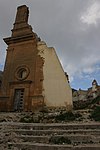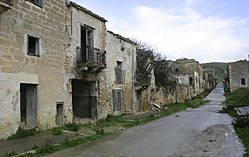Ruins of Poggioreale are the remains of the city of Poggioreale destroyed by the 1968 Belice earthquake and are located in Sicily.
To know
Geographical notes
Poggioreale extended along the slope of a hill. In fact, the city is on a slope. Corso Umberto I is the access road that reaches Piazza Elima where the main buildings are located.
When to go
It can be visited at any time of the year.
How to get
By car
It is the only useful means of transport to reach the site.
From Sciacca you take the ![]() and then turn onto the
and then turn onto the ![]() going out to Poggioreale from here take the
going out to Poggioreale from here take the ![]() and at the end you turn right.
and at the end you turn right.
From Trapani or Palermo take the ![]() direction Mazara del Vallo, take the Gallitello exit towards Poggioreale, Camporeale, Salaparuta then take the
direction Mazara del Vallo, take the Gallitello exit towards Poggioreale, Camporeale, Salaparuta then take the ![]() after about 5 km, turn left until you take the
after about 5 km, turn left until you take the ![]() , then on the right you take the
, then on the right you take the ![]() that becomes
that becomes ![]() finally you turn right before it becomes the same
finally you turn right before it becomes the same ![]() up to the entrance gate.
up to the entrance gate.
Permits / Rates
- 1 Entrance. Access is free and open.
How to get around

Inside the old city you can move only on foot. Cars cannot enter due to the presence of a gate.
What see
- 1 Agosta Palace. Almost intact building visible at the entrance to the site.
- 2 Palazzo Principe Morso.

- 3 Municipal Schools, Corso Umberto I. A relatively modern building compared to the other buildings, with three floors and fairly intact in the main structure. In hell you can see the classrooms and a few remaining desks.
- 4 Municipal Theater.
- 5 Municipal building.
- 6 Church of the Addolorata.
- 7 Church of S.Antonio of Padua.

- 8 Elima Square. A large square on which you can have an overall view of the ruins. On one of the facades there is a fascist DVX inscription.

- 9 Church of the Purgatory, Elima Square. Of this church only the supporting structures and the apse remain. In front of it there is a monument.

- 10 Oratory of the SS. Sacrament (A short distance from the Mother Church, along the staircase that begins in Piazza Elima). The church, although destroyed, has an almost intact facade.

- 11 mother church (At the end of the staircase that begins in Piazza Elima). Of the old mother church, only part of the facade remains, supported by a reinforced concrete reinforcement.
- 12 Cannoli source.
- 13 Municipal fish market.

- 14 Church of Jesus and Mary. This church has an intact staircase and you can see the altar with a single nave. Below it is the crypt partially visible from the hole in the floor and the hole in the side wall.
- 15 Convent of the Capuchin Friars.
- D'Antoni Mirto Impastato Hospital.
- Church of the Hospital.
- Cangelosi Female Orphanage.
What to do
The site lends itself as an exceptional photographic set.
Shopping
Where to eat
Where stay
Safety
By accessing the site you will notice a sign calling for caution. The buildings are crumbling and the danger is around the corner. Avoid venturing inside the ruins due to the risk of collapsing, but above all do not go up to the upper floors as you are not aware of the state of the load-bearing walls. In any case, access is at your own risk.
How to keep in touch
Around

- 2 Cretto di Burri (cretto di Gibellina or Grande Cretto) (from Gibellina take the
 towards Santa Ninfa, then take the
towards Santa Ninfa, then take the  and then turn into the
and then turn into the  following the directions). Alberto Burri's great work was erected between 1984 and 1989 on the ruins of the old Gibellina. Burri designed a gigantic monument that retraces the streets and alleys of the old city: in fact it stands in the same place where once there were the rubble, currently cemented by the work of Burri. Each slit is two to three meters wide, while the blocks are about one meter and sixty high and have an area of about 80,000 square meters, making it one of the largest contemporary works of art in the world.
following the directions). Alberto Burri's great work was erected between 1984 and 1989 on the ruins of the old Gibellina. Burri designed a gigantic monument that retraces the streets and alleys of the old city: in fact it stands in the same place where once there were the rubble, currently cemented by the work of Burri. Each slit is two to three meters wide, while the blocks are about one meter and sixty high and have an area of about 80,000 square meters, making it one of the largest contemporary works of art in the world. - Gibellina
- Salaparuta
- Santa Margherita del Belice
Other projects
 Commons contains images or other files on Ruins of Poggioreale
Commons contains images or other files on Ruins of Poggioreale

